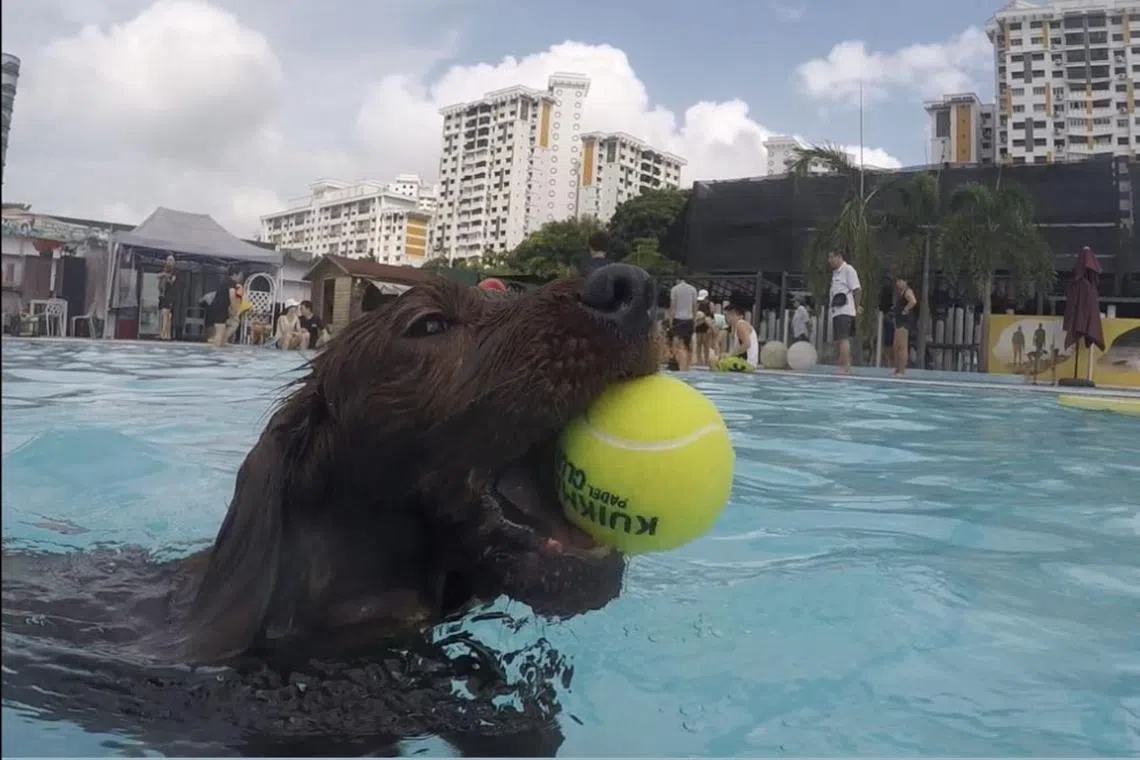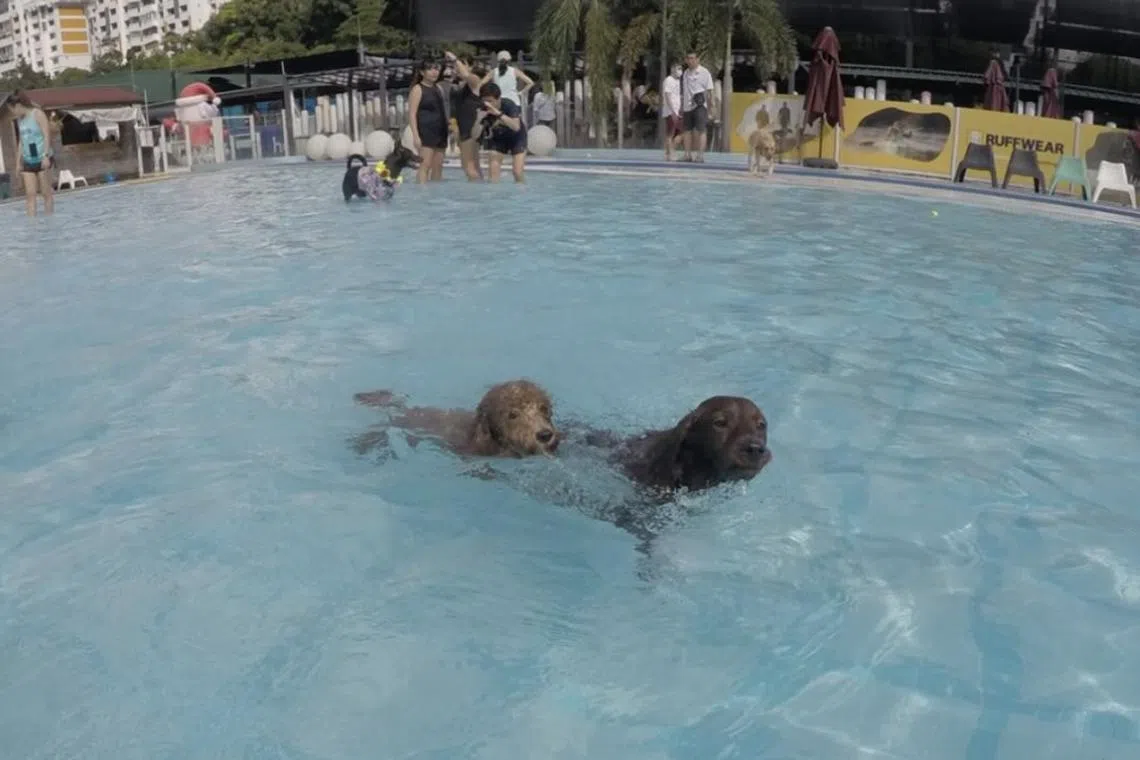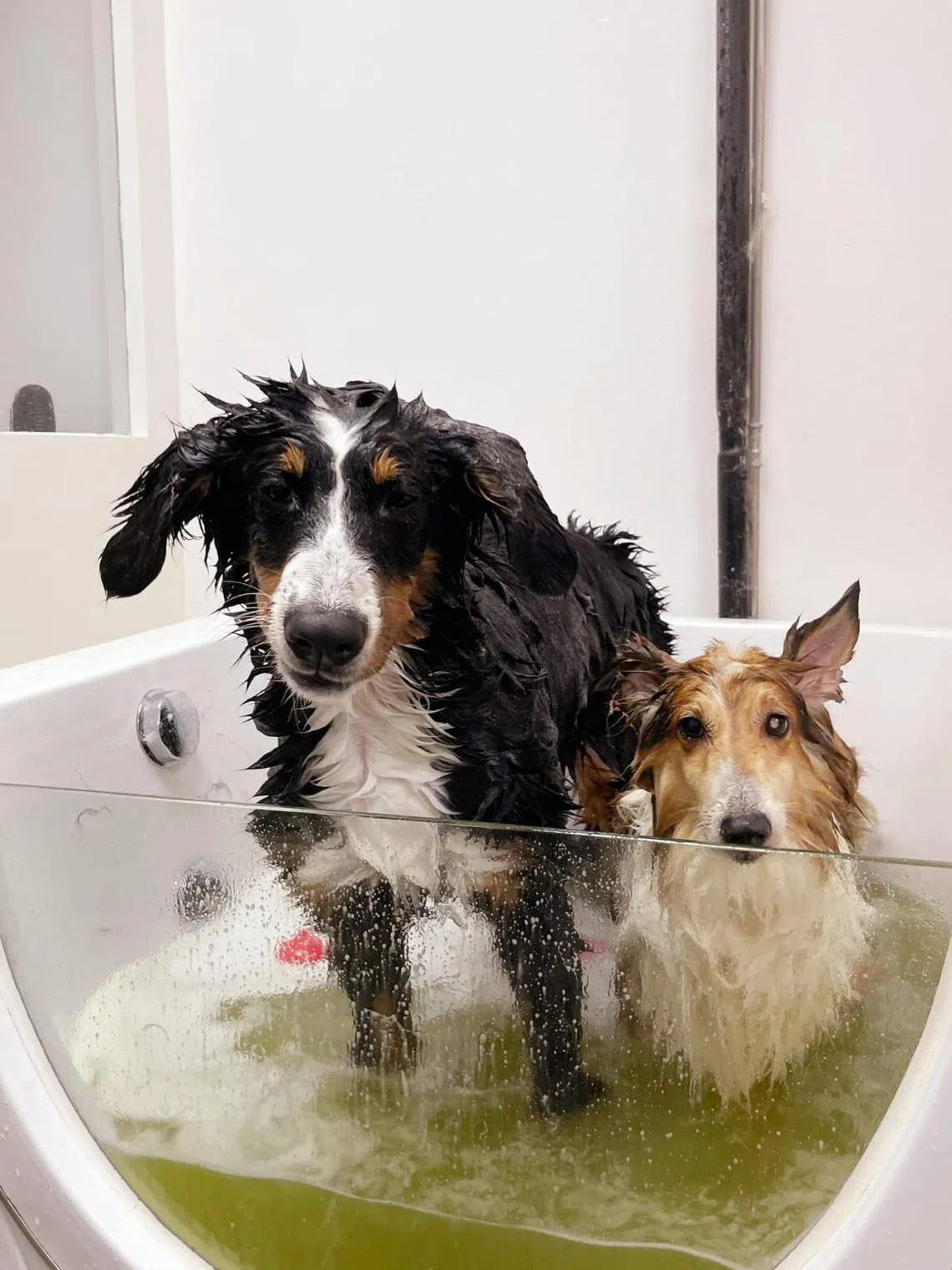Don’t let the dogs out: How to keep your pets safe during extreme heat
Sign up now: Get ST's newsletters delivered to your inbox

Mocha, a cockapoo, enjoying a cool dip in the pool. The pet's owner, Ms Janice Tham, who has another dog – a maltipoo named Latte – now opts to take them to pools and indoor places instead of walks outdoors.
PHOTO: COURTESY OF JANICE THAM
Follow topic:
SINGAPORE – As temperatures hit the mid-30s in recent weeks, Ms Grace Yoong noticed a change in her two dogs.
“Kaiza (a Bernese mountain dog) has been drinking a lot, whereas Stinky (a Shetland sheepdog) is drooling a lot more than usual,” said Ms Yoong, 34, who runs an employment agency.
“They are also suffering from some heat rash.”
Sensing that her dogs were affected by the heat, which hit a high of 36.3 deg C in Choa Chu Kang on March 24
For a start, Ms Yoong now walks them at around 8.30am and 6pm daily, avoiding the midday sun.
“On top of that, we give them ice water and feed them dog popsicles once in a while,” she added.
The hot weather looks set to stay in 2024,
Ms Janice Tham, 35, noticed that her dogs – maltipoo Latte and cockapoo Mocha – seemed to be drinking a lot more water than usual. The administrative executive now opts to take them to a pool and indoor places such as pet-friendly malls and cafes for weekend activities, instead of going for walks outdoors.

Ms Janice Tham’s maltipoo Latte and cockapoo Mocha (left) enjoying a swim in the pool on March 31.
PHOTO: COURTESY OF JANICE THAM
Vets told The Straits Times that as the weather in Singapore gets warmer, it is crucial for owners to protect their pets from heat stress.
Dogs are more susceptible to overheating compared with humans, said Dr Teo Boon Han of VetTrust Singapore, as they regulate their body temperature primarily through panting.
Those with shorter snouts and faces – known as brachycephalic dogs – are more prone to heat stress, say vets. These include breeds such as pugs, Boston terriers, and English and French bulldogs.
Brachycephalic dogs are “inefficient” at panting due to their shorter faces, which makes it harder for them to dissipate heat and regulate their temperature effectively, said Dr Lee Yee Lin, veterinary medical director of Gentle Oak Veterinary Clinic.
Older dogs, dogs with heart or lung disease, obese dogs and those with thick coats could also find it harder to regulate their temperature under extreme heat, said Dr Angeline Yang of VetMobile.
“Heat may send them into respiratory distress,” she warned.
Know the signs of heat stress
If owners think their pets are suffering heat stress, measures to cool them down should be taken immediately, and some might even have to be rushed to the vet.
Panting is usually the first sign of heat stress, said Dr Lee. “As it progresses, you might see severe drooling and salivating, and some of them might even look slightly dazed,” she added.
A faster heart rate and signs of lethargy are also telltale indications, added Dr Teo.
Should dogs display such signs, owners can try to reduce their pet’s body temperature by wetting their ears and paws with a spray or cloth.
“Dogs lose most heat through the extremities, so wet their ears and paws down to allow active cooling to happen,” said Dr Lee.
To avoid hypothermia, owners should stop once the dog’s temperature returns to normal.
Owners should also keep a digital thermometer with them at all times, and rush to the vet if their pet’s body temperature exceeds 40.5 deg C, she added.
She urged dog owners not to take heat stress lightly.
“Do not assume that just because you have given your dog water, it will be fine. If there is a patient with heat stress and you don’t bring the body temperature down fast enough, the dog will get multi-organ damage very quickly.”
Exercise caution and common sense
Owners should exercise caution and common sense when making decisions in daily activities, such as not taking their dog outdoors for a prolonged period of time.
“Realistically speaking, if it is super hot, sometimes just putting ourselves in the dog’s shoes may help us with our decision-making,” said Dr Lee.
“If it is super hot out there, even if I am in a tiny singlet, I am still going to overheat under the sun.”
Products such as cooling vests and shoes might provide temporary relief against the heat, said vets.
Footwear may prevent dogs from scalding their paws on hot ground, especially on concrete and asphalt, said Dr Yang. “But if the ground is so hot, dogs shouldn’t be walked in the first place.”
Clothing may block out ultraviolet rays and prevent sunburn, but is “usually not necessary” and may prevent heat loss by convection.
“Fur serves as natural skin protection against UV rays. Wetting their coat to cool them may work better – through evaporation,” she said.
Such products are by no means a foolproof method to prevent heat stress, said Dr Lee, and owners still have to be careful.
Owners should not assume that walking in a shaded area or playing at the beach will not induce heat stress in a dog, she added.
“If they play excessively, it can build up temperature. Sometimes running around under the hot sun, the dog can still get heat stroke.
“If it is noon, I wouldn’t be putting my dogs out at all. It is not just the heat, our humidity makes it a lot worse. If you put your foot on the floor and it is burning your foot, it is way too hot to put your dog’s paw on it,” she said.
She also noted that breeds like huskies and malamutes, which were bred for colder climes like Siberia and Alaska, “really should not be out walking”.
Business heats up for some in the pet industry
While the heat has been a bane for dogs and their owners, it has been a boon for some in the pet trade.
Some groomers have seen a surge in demand, with pet owners asking for their furbabies to be trimmed or clipped.
In the last two weeks of March, D.O.G Department of Grooming in Changi Road experienced a 70 per cent increase in owners requesting shorter haircuts for their pups.
There are also many owners with double-coated breeds, such as Siberian huskies and Japanese Spitz, inquiring about shaving their dogs, said director Shawn Ho.
But shaving is not advised, he explained, as “it exposes their naked skin to the intense heat and damaging effects of direct sun exposure”.
Groomer at Pawpy Kisses Hub Carol Lau went to work two hours earlier during the last two weeks of March to cater to the spike in customers. Traffic at the shop in Balestier increased by about 30 per cent that month, she said.
Ms Yoong, 34, said she decided to send Kaiza and Stinky for a haircut, bath and spa treatment on March 18 due to the recent “extreme heat”.

Ms Grace Yoong decided to send her Bernese mountain dog Kaiza (left) and Shetland sheepdog Stinky for a haircut, bath and a spa treatment on March 18.
PHOTO: COURTESY OF GRACE YOONG
To cool down their pets, owners are also taking their dogs for a dip in the pool and buying cooling products such as vests and mats.
A spokesperson for Arrr Singapore, a brand selling pet products, said demand for cooling blankets increased by between 5 per cent and 10 per cent in the month of March.
It is expecting an increase of up to 15 per cent for the product made of materials such as cooling yarn and fabric which acts as a cushion for dogs to lie on.
More dogs are also making a splash at swimming pools.
Traffic at the indoor pool at Wagging Tails N Playful Paws has been inching up since mid-January, and the number of pups as at March is 10 per cent more than when the increase started.
Owner Calista Ariana attributes this increase to the heat, and said swimming pools are a way to allow pooches to “exercise in a cool area to prevent heat stroke”.
Ms Tham took Mocha and Latte to a dog waterpark in Jurong on March 31. “They were able to play for a longer time in the pool compared with parks, and seemed to be panting less,” said Ms Tham, who added that they would likely return within two to three weeks.
While all the vets ST spoke to did not report an increase in dogs needing treatment for heat stress, they warned owners not to let their guard down.
“Heat stress, heat stroke and death from heat stroke should be a very preventable thing.
“Don’t assume that our dogs are going to cool down as fast as we do,” said Dr Lee.
Some ways owners can protect their pets from heat exhaustion:
Avoid excessive exercise during hot weather, and provide access to shade and plenty of fresh drinking water.
Mist your dog with cool or room-temperature water or place a fan in front of your dog to encourage evaporative cooling
Ensure that the environment is well ventilated, or even air-conditioned.
Avoid walking on hot surfaces, such as on the road and pavements during and right after a hot day.
Do not leave your dog alone in a car or while outdoors, even for a few minutes.


